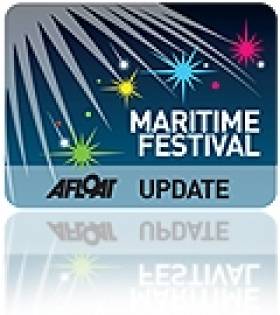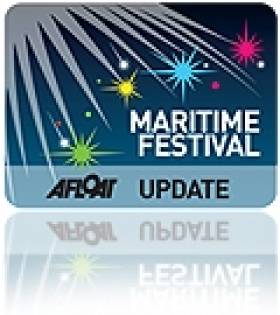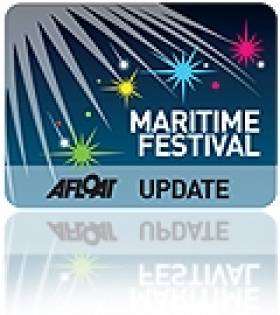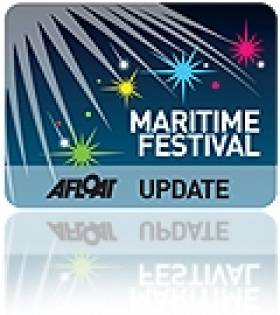Displaying items by tag: Maritime Festival
Lifeboat Prawn Push in aid of Howth RNLI
#lifeboat – As part of the Dublin Bay Prawn Maritime Festival in Howth, North Dublin a Prawn Push in aid of Howth RNLI will take place on Saturday 27th April at 3pm in Howth.
Teams of three wearing maritime themed fancy-dress will take part. One member of the team will push another team-member in a pram or wheelbarrow. The other team-member will have the task of passing around a collection bucket until its weight matches the weight of a kilo of prawns.
The route will start at the Top House Pub in Howth village, via Church Street to Findlater's Pub and back to the children's playground near the east Pier. Rehydration stations will be set up along the route where competitors will have to down a drink as fast as they can. Prizes awarded will include winners of the race and best fancy-dress. Prize-giving will take place at the Festival Marquee immediately after the race.
Teams can be from pubs, clubs or groups. All participants must be over 16 years of age. Teams must supply their own prams or wheelbarrows. Entries and enquiries can be made to Eddie Caffrey on 086 832 0786 or by email to [email protected] .
'Funds raised by the Lifeboat Prawn Push will ensure that our volunteer lifeboat crews go to sea with the best equipment available to ensure their safety when saving lives at sea' said Rose Michael, Howth RNLI Fundraising Chairperson.
Wexford Prepares for Second John Barry Maritime Festival
#maritimefestival – The organisers of the John Barry Maritime Festival are expecting crowds of over 50,000 to visit Wexford in June. The second John Barry Maritime Festival, which is one of three Gathering flagship events, takes place this year from Thursday 20th until Sunday 23rd June in Wexford and promises to be bigger and better than the inaugural festival in 2012, which saw crowds of 35000 over the two day event.
The idea originated in January last year after a lifeboat visit to the Waterford Coast Guard Helicopter base. The three RNLI volunteers David Maguire, Frank O Brien and Lorraine Galvin were discussing plans to celebrate Wexford Lifeboat Station 10 year anniversary. "..ideas for fun on the quay developed into an idea for a maritime festival" says Lorraine, " with maritime activities, races, childrens activities, live music and entertainment, exhibitions, cultural events and the hugely successful Wexford food familys food village". It was wonderful to see so many children on the quay enjoying kayaking and boating, arts and crafts, science experiments, the funfair and my own little toddler dancing away at the Kindermusik sessions".
As well as family fun, the festival also celebrates Wexford man Commodore John Barry, father of the US Navy. In September last year the festival directors invited over two US Navy Rear Admirals to Wexford and discussed plans for this years festival and forming links with the US Navy. "...The Rear Admirals had great admiration for John Barry and were very interested in learning more of his heritage and home town told by historian Bernard Brown" said Frank O Brien.
David Maguire saif that the festival success was down to great community support and invovlement.." Wexford has such a great maritime heritage and we want to show it off, we are working with great local groups and the best of Wexford food producers, it will be a real Wexford showcase".
The three have been busy already securing the festival as a flagship gathering event and are actively inviting international visitors to Wexford for the festival. "There are so many wonderful events in the planning, Wexford Quay is such an amazing amphitheatre for a festival and what better view than Wexford Harbour!" The festival is non profit organisation with fundraising proceeds towards Wexford RNLI Lifeboat. Any interested groups are invited to contact the team at [email protected] or through the website www.jbmf.ie
Galway Festival 'An Tóstal Salthill' Seeks Wider Maritime Involvement
#maritimefestival – All Ireland Currach racing will run along the promenade of Salthill and there will also be a Galway Hooker parade of sail as part of this year's 'An Tóstal Salthill' on Sunday, May 5.
Festival Director Diarmuid Ó Conghaile says there will be a live bi-lingual commentary of the races throughout the day and live music and entertainment late into the night.
'An Tóstal Salthill' is a free festival and has been very well attended with estimated crowds of 10,000 converging on the Galway bay seafront since its revival two years ago after a gap of 50 years. Ó Conghaile is hoping to build on successes to date and attract a wider portion of the maritime community.
New Ross Celtic River Festival
#RIVER FESTIVAL – The inland port of New Ross,Co. Wexford, is to where the Celtic River Festival is to take place over next weekend (25-26 Aug).
The festival has an action packed programme to entertain with plenty of fun-filled activities for all to enjoy. The events are a cruiser treasure hunt, Viking longboat trips, cot-racing, music sessions, Viking camp and medieval fair, a kids workshop and sea scout camp and archery.
For further details visit their facebook page by clicking HERE
Wexford to Celebrate Maritime Heritage with Summer Festival
#MARITIME FESTIVAL – The John Barry Maritime Festival takes place on the 23rd and 24th of June 2012 on Wexford Quay, celebrating Wexford's culture and heritage on a seascape setting in the heart of Wexford town. Wexford maritime culture will be showcased with programmed events included a rowing regatta of traditional sailing cots to modern fibre glass rowing boats, sea kayaking, canoeing, sailing and raft races on view from Wexford Quay marina. A 26000 square foot exhibition centre will house over 100 handcrafted model boats, interactive media exhibitions of local maritime activites (John Barry, Irish Naval Service, Irish Whale and Dolphin Group and the Wexford Lifeboat). The harbour itself will be a visual array of boats and the RNLI, Coastguard, Irish Whale and Dolphin Group and Met Eireann will also be on the quay providing information and demostrations to the public on marine safety.
The festival celebrates and brings recognition to Wexford born Commodore John Barry, father of the US Navy. Links with the US navy are being established and a contingent from the US Navy will visit and partake in the festival. The festival hopes to build upon this link with its sister city Annapolis, Maryland. An annual John Barry Memorial Ceremony officiated by Major of Wexford Davy Hynes brings national and international dignitories. Exhibitions on John Barry, a visual installation of a John Barry themed image on the Ballast Office building and the participation of US and Irish Navy will also highlight the important heritage connection of Wexford and John Barry.
Wexford maritime art culture will be showcased in various art galleries around Wexford town, an Art in the Open event on Wexford Quay and childrens art workshops. Musical and dance entertainment during the day lasts the entire weekend with traditional Irish music and local dance groups. Wexford local food producers will be showcasing their fresh produce on the quay to develop awareness of local artisan products that are specific to Wexfords food culture.
The family orientated festival includes childrens arts and crafts activites, a pirate treasure hunt and scavenger hunt, dancing and outdoor fun (rock climbing wall, rope climbing wall, sumo wrestling, gladiators etc). An awareness of local maritime attractions will be raised through the display of races, exhibitions and stalls of the various groups, including Shielbaggan Outdoor Adventure Centre, Rowing Clubs, Wexford Harbour Boat and Tennis Club.
Boats Head for 'Foyle Days' 2011
Over the years she has changed hands between Dutch and UK interests for recreational use. Several years ago she starred in the RTE TV reality show 'Cabin Fever' where she replaced the show's first ship Camaret of Cornwall (branded as 'Cabin Fever') after it ran aground off Tory Island.
During the two-day festival (11am-5pm) the boating community at the event will include the Coleraine Yacht Club, Foyle Paddlers, Foyle Punts, Lough Foyle Yacht Club, Lough Swilly Yacht Club, Moville Boat Club, RNLI and the Foyle (SAR) Search and Rescue.
Visitors to Foyle Days can call to the Clipper stand and learn more about the city's entry of the Derry~Londonderry boat in the 2011-2012 Clipper Round the World Race. Learn more about the countries the crew will visit and also how to get involved in the event. For more information about the race, at 40,000 miles is the world's longest race go to www.clipperroundtheworld.com/
Running alongside the festival a continental market with 40 stalls will be open to all at the recently revamped Guildhall Square. For further details about Foyle Days click here.
- Clipper Race
- Maritime Festival
- RNLI
- Lough Foyle Yacht Club
- Lough Swilly Yacht Club
- Moville Boat Club
- Derry
- Londonderry
- Tory Island
- JOHANNA LUCRETIA
- Foyle Days
- RTE TV
- Cabin Fever
- Camaret of Cornwall
- Grounding
- Reality TV show
- Clipper Around the World Race
- Guildhall Square
- Continental Market
- Coleraine Yacht Club
- Foyle Search and Rescue
- Foyle Paddlers
- Foyle Punts
- Offshore Sailing
- Clipper Round The World Race
- JOHANNA LUCRETIA
Irish Sailing and Boating Regattas and Maritime Events
Reporting on the latest race news and regatta information is the one of the most important aspects of the Afloat.ie website. This page covers everything from round the world race stopovers, the arrival of the Tall Ships as well as domestic boat shows and a calendar of events.


































































